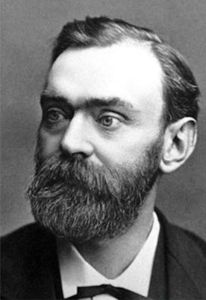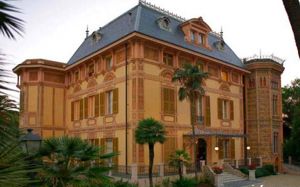Industrial Chemist
 Alfred Nobel was born in Stockholm on 12 October 1833, the last descendant of an ancient Swedish family.
Alfred Nobel was born in Stockholm on 12 October 1833, the last descendant of an ancient Swedish family.
He studied in Petersburg, where his father ran the shipyards, and returned to Stockholm in 1859.
He became interested in the use of nitroglycerine as an explosive and in 1863 he started to make it in a small laboratory in Heleneborg, in the Swedish capital, after a few months the laboratory was destroyed by an explosion in which his younger brother, Emil, died. He installed a new factory in Vinterviken and then another one in Germany, in Hamburg. During his experiments he discovered the possibility of triggering the detonation of nitroglycerin by means of mercury fulminate.
In 1877 he discovered that, by absorbing three parts of nitroglycerin by weight from one part of kieselguhr, it was possible to obtain an explosive mixture much more manageable and less dangerous than liquid nitroglycerin, to which he gave the name "dynamite". In 1875 he invented rubber dynamite. In 1887 he proposed a propulsive powder, which he called "ballistite", consisting of a mixture of nitroglycerin and nitrocellulose in almost equal parts. Established in Paris after 1873, in 1881 he installed a new laboratory in Saint-Sevran (Seine and Oise), where he continued his research for the improvement of dynamite, and in 1890 he moved the laboratory to the Villa Nobel in Sanremo. He died in Sanremo on 10th December 1896.
Established in Paris after 1873, in 1881 he installed a new laboratory in Saint-Sevran (Seine and Oise), where he continued his research for the improvement of dynamite, and in 1890 he moved the laboratory to the Villa Nobel in Sanremo. He died in Sanremo on 10th December 1896.
Alfred Nobel was well inserted in the events of his time, of which he loved to be informed by deepening currents of thought and dealing with philosophy; he had read many texts, in particular French and English fiction. Already in his lifetime he is remembered as a generous and modest donor of large sums of money. But his many cultural interests and financial fortunes never made him a happy man, as can be seen from the many letters he wrote (an exchange of letters with a lady was only recently made public). He had cultivated a long relationship with her and from their letters emerges a portrait of a solitary man, almost ascetic, overworked and consequently hypochondriac to the point of health obsession; to whom high society, which he did not frequent, repelled, only indulging in a few races through the streets of San Remo aboard a carriage drawn by his black Orlov horses.
He made a will that almost all his fortune was destined to a foundation of five annual prizes: the "Nobel Prize" for those who rendered the greatest services to humanity in the fields of physics, chemistry, physiology and medicine, letters and peace.
For the latter sector, the prize (which, in addition to the sum of money, also consists of a gold medal and a diploma of honour) is awarded to those who have distinguished themselves in promoting brotherhood between peoples, the reduction of permanent armies and the establishment of peace congresses.
In the years when the Nobel Peace Prize was not awarded (which has happened several times) special institutions were set up to provide the available funds.
(sources: different authors; private archive images)




